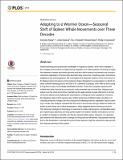Files in this item
Adapting to a warmer ocean – seasonal shift of baleen whale movements over three decades
Item metadata
| dc.contributor.author | Ramp, Christian | |
| dc.contributor.author | Delarue, Julian | |
| dc.contributor.author | Palsbøll, Per J | |
| dc.contributor.author | Sears, Richard | |
| dc.contributor.author | Hammond, Philip Steven | |
| dc.date.accessioned | 2015-03-23T15:01:01Z | |
| dc.date.available | 2015-03-23T15:01:01Z | |
| dc.date.issued | 2015-03-18 | |
| dc.identifier | 169909041 | |
| dc.identifier | ec386ddc-1141-4c44-8d87-2d07ed5111fe | |
| dc.identifier | 84925428046 | |
| dc.identifier | 000352138500210 | |
| dc.identifier.citation | Ramp , C , Delarue , J , Palsbøll , P J , Sears , R & Hammond , P S 2015 , ' Adapting to a warmer ocean – seasonal shift of baleen whale movements over three decades ' , PLoS One , vol. 10 , no. 3 , e0121374 . https://doi.org/10.1371/journal.pone.0121374 | en |
| dc.identifier.issn | 1932-6203 | |
| dc.identifier.other | ORCID: /0000-0002-2381-8302/work/47531650 | |
| dc.identifier.uri | https://hdl.handle.net/10023/6290 | |
| dc.description | Date of Acceptance: 11/02/2015 | en |
| dc.description.abstract | Global warming poses particular challenges to migratory species, which face changes to the multiple environments occupied during migration. For many species, the timing of migration between summer and winter grounds and also within-season movements are crucial to maximise exploitation of temporarily abundant prey resources in feeding areas, themselves adapting to the warming planet. We investigated the temporal variation in the occurrence of fin (Balaenoptera physalus) and humpback whales (Megaptera novaeangliae) in a North Atlantic summer feeding ground, the Gulf of St. Lawrence (Canada), from 1984 to 2010 using a long-term study of individually identifiable animals. These two sympatric species both shifted their date of arrival at a previously undocumented rate of more than 1day per year earlier over the study period thus maintaining the approximate 2-week difference in arrival of the two species and enabling the maintenance of temporal niche separation. However, the departure date of both species also shifted earlier but at different rates resulting in increasing temporal overlap over the study period indicating that this separation may be starting to erode. Our analysis revealed that the trend in arrival was strongly related to earlier ice break-up and rising sea surface temperature, likely triggering earlier primary production. The observed changes in phenology in response to ocean warming are a remarkable example of phenotypic plasticity and may partly explain how baleen whales were able to survive a number of changes in climate over the last several million years. However, it is questionable whether the observed rate of change in timing can be maintained. Substantial modification to the distribution or annual life cycle of these species might be required to keep up with the ongoing warming of the oceans. | |
| dc.format.extent | 15 | |
| dc.format.extent | 414764 | |
| dc.language.iso | eng | |
| dc.relation.ispartof | PLoS One | en |
| dc.subject | QH301 Biology | en |
| dc.subject | DAS | en |
| dc.subject | SDG 13 - Climate Action | en |
| dc.subject.lcc | QH301 | en |
| dc.title | Adapting to a warmer ocean – seasonal shift of baleen whale movements over three decades | en |
| dc.type | Journal article | en |
| dc.contributor.institution | University of St Andrews. School of Biology | en |
| dc.contributor.institution | University of St Andrews. Sea Mammal Research Unit | en |
| dc.contributor.institution | University of St Andrews. Marine Alliance for Science & Technology Scotland | en |
| dc.contributor.institution | University of St Andrews. Scottish Oceans Institute | en |
| dc.contributor.institution | University of St Andrews. Centre for Research into Ecological & Environmental Modelling | en |
| dc.identifier.doi | https://doi.org/10.1371/journal.pone.0121374 | |
| dc.description.status | Peer reviewed | en |
This item appears in the following Collection(s)
Items in the St Andrews Research Repository are protected by copyright, with all rights reserved, unless otherwise indicated.

